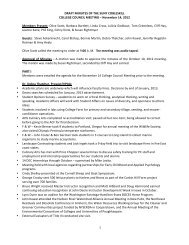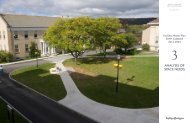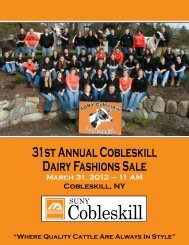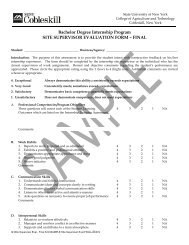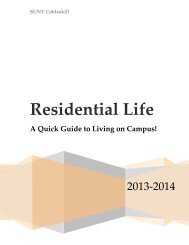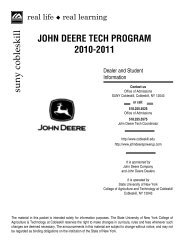Part 5: Final Recommendation - SUNY Cobleskill
Part 5: Final Recommendation - SUNY Cobleskill
Part 5: Final Recommendation - SUNY Cobleskill
Create successful ePaper yourself
Turn your PDF publications into a flip-book with our unique Google optimized e-Paper software.
J<br />
LANDSCAPE<br />
PLAN<br />
<strong>SUNY</strong> <strong>Cobleskill</strong> Facilities Master Plan – Phase 5 Report<br />
November 2011<br />
J – LANDSCAPE PLAN<br />
Additionally, there is a high possibility of lead and PCBs in the existing<br />
electrical system on the west side of campus based upon age.<br />
The cost of this recommendation is not carried by the FMP as it is considered<br />
part of the College’s critical maintenance needs. Coordination with site<br />
improvement efforts, however, should be done when possible.<br />
DATA<br />
While this data and technology issues are presented in greater detail<br />
in Section M (Technology) it is generally understood that the campus’<br />
data infrastructure has inadequate redundancy and is at capacity. The<br />
FMP recommends that the College undertake a study and chart how the<br />
campus envisions both rationalizing and expanding the current system.<br />
As with the significant electrical system upgrades, data upgrades should<br />
be coordinated to minimize site disturbance and combine with other<br />
infrastructure work for cost savings.<br />
As this issue requires significant additional study, it is not an initiative of the<br />
FMP and project costs are not carried in the FMP’s budget. Additionally,<br />
this work should also be coordinated with initiative 1F - Upgrade General<br />
Classroom Technology Campus-wide, which involves the installation of<br />
data backbones in all instructional buildings, new data closets and multimedia<br />
capabilities.<br />
The facilities master plan [FMP] team, in conjunction with the College,<br />
has identified planning objectives that, taken together with critical design<br />
drivers such as infrastructure and programmatic needs, guide the design<br />
and development of campus spaces. These objectives are considered not<br />
only in the planning of new buildings but also in the design of the campus<br />
landscape spaces.<br />
The principle of providing opportunities for experiential learning is evident<br />
in throughout all three of the concept alternatives. <strong>SUNY</strong> <strong>Cobleskill</strong> is set<br />
apart by its emphasis on hands-on learning, giving students the unique<br />
advantage of practical experience and theoretical knowledge. To this<br />
end, the FMP approaches the landscape as a laboratory for real-world<br />
learning.<br />
The Lower Quad, for example, can include exposed storm water<br />
infrastructure that is necessary for the campus, but also provides visual<br />
interest and opportunities for learning in outdoor classrooms. Science<br />
curricula related to water quality, sustainability, and bio-geo-chemical<br />
processes may also have the opportunity to use the campus’s storm<br />
water management practices as a tool for learning. Outdoor spaces may<br />
contain teaching gardens or an arboretum—features that are not only<br />
attractive but useful.<br />
The objective of breaking down the socio-cultural divisions within the<br />
<strong>SUNY</strong> <strong>Cobleskill</strong> campus is supported by the effort to strengthen the<br />
physical connection between the east and west sides of the campus. In<br />
the final FMP a crossing at Route 7 is established in alignment to the<br />
Student & Community Center. Traffic-calming treatments, such as median<br />
islands, human-scale lighting, signage, pedestrian-actuated signals, and<br />
varied road widths, are applied at the primary pedestrian crossing. The<br />
reconfigured crossing of Route 7 provide an essential link between the<br />
two sides of the campus.<br />
established at a highly visible location that can be easily accessed by<br />
the general public such as the main campus entry at Schoharie Parkway<br />
south and may include a modest amount of nearby parking.<br />
In addition to the planning objectives identified by the College, a second<br />
set of summary design principles are proposed for the campus landscape.<br />
These ideas guide the development of the campus landscape as a unified,<br />
safe and attractive environment. These principles include:<br />
•<br />
•<br />
•<br />
Simplify<br />
• Replace unnecessary stairs and ramps; mitigate grade<br />
changes with landscaping strategies where it is possible<br />
• Eliminate redundancies such as parallel walkways<br />
• Provide centrally located, uncluttered, open green<br />
spaces<br />
Reduce<br />
• Set standards for lighting, paving materials and site<br />
walls<br />
• Utilize local materials and native vegetation to reduce<br />
maintenance<br />
• Remove unnecessary pavement<br />
• Develop landscape management zones that assign<br />
reduced management areas<br />
Design with the land<br />
• Organize circulation along natural patterns of movement<br />
as suggested by desire lines and the natural topography<br />
of the site<br />
• Provide universal access by creating a circulation network<br />
that moves along the contours of the land<br />
• Engage the creek by providing access<br />
In addition to creating opportunities for the Village and Town of <strong>Cobleskill</strong><br />
community to be involved with the campus, such as the farm market and<br />
community-oriented programs, a larger effort can be made to connect<br />
the campus to the community through landscape. The development of<br />
the <strong>Cobleskill</strong> Creek Trail will provide an amenity on the campus that<br />
attracts students as well as the larger community. Developing this feature<br />
as a public space presents a strong statement about <strong>SUNY</strong> <strong>Cobleskill</strong>’s<br />
commitment to being a good neighbor. The trail head should be<br />
28



